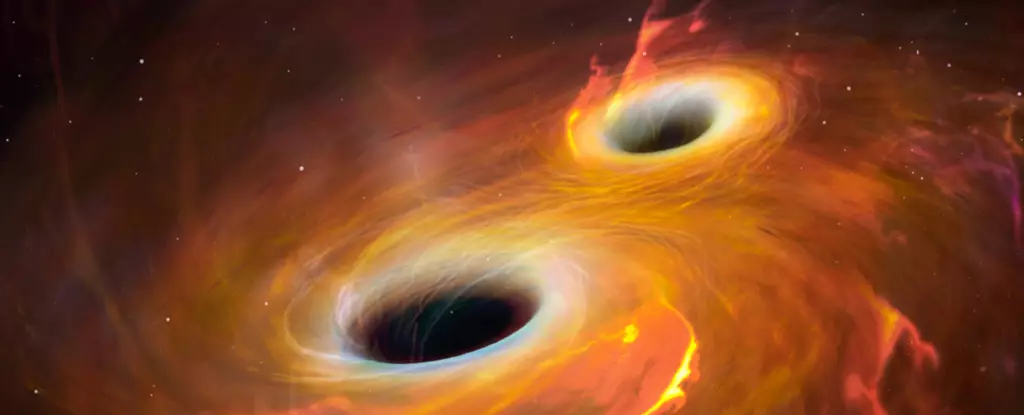At the heart of our galaxy lies an enigmatic region that pulses with energy and chaos, a place where the gravitational grip of a supermassive black hole, Sagittarius A*, is just one of many forces at play. This vibrant locale is not merely a vacuum; it is a swirling cauldron of young stars, gas, dust, and varied celestial phenomena. The complexity of this region challenges traditional astronomical views, particularly when it comes to the presence of stellar-mass black holes that might be lurking amid the cosmic clutter.
Invisible Yet Present: The Veil of Interstellar Material
Surrounding Sagittarius A* is a dense veil composed of interstellar gas and dust, effectively obscuring our view in the visible spectrum. Conventional telescopes struggle to penetrate this shroud, leading astronomers to rely on infrared and radio observations to glean insights into the stars and gas residing close to the supermassive black hole. Despite these advanced methods, stellar-mass black holes remain elusive, often shrouded in mystery. Estimates vary widely, suggesting anywhere from a few hundred to potentially millions of these celestial enigmas exist in the core of our galaxy.
Challenging Established Models: The Rise of the ‘Star Grinder’ Theory
Recent research published in Astronomy & Astrophysics proposes a radically different viewpoint. Traditionally, models have suggested that only about 300 stellar-mass black holes are located in the vicinity of Sagittarius A*. However, the new study paints a more complex and chaotic picture: a “star grinder” model. It posits that the dense concentration of gas and dust facilitates the rapid formation of massive O-type and B-type stars, which, due to their short lifetimes, inevitably end their existence in supernova explosions, leaving behind stellar-mass black holes.
These black holes, in turn, would contribute to a cyclical regeneration process. Each time a star forms and then dies, it contributes to the growing population of black holes, densely packing the center of our galaxy over time. As noted in the study, this “grinding” effect could lead to a scenario where black holes interact frequently with new stars, ultimately creating a hazardous environment where any star venturing too close might face a grim fate.
Collision Time: Unraveling the Statistical Enigma
The challenge now lies in providing empirical support for this provocative model. The study utilizes a statistical measure known as collision time to explore the likelihood of stars encountering black holes in this densely populated region. The concept is straightforward yet profound: given a certain density of black holes, one can calculate the average time before a star collides with a black hole. Increased black hole density correlates with decreased collision time, while the size of stars also plays a crucial role.
Using this formula, the research delineates two prominent observations: the relative scarcity of the largest O-type stars near Sagittarius A* and the abundance of smaller B-type stars. The implications are telling; O-type stars seem to undergo frequent interactions with black holes, supporting the idea that they are effectively “grounded” by the gravitational turmoil of their surroundings.
The Specter of Hypervelocity Stars: A Cosmic Consequence
Among other phenomena, the newly minted star grinder model could also elucidate a peculiar mystery linked to hypervelocity stars—those rare celestial bodies zooming through the galaxy at velocities that could allow them to escape our Milky Way entirely. Close encounters with black holes provide a plausible mechanism for this extraordinary acceleration. By examining the data on these hypervelocity stars, researchers can further corroborate the existence of the previously hypothesized dense population of black holes.
In essence, the star grinder concept not only redefines our understanding of the stellar lifecycle at the center of our galaxy but also opens up new avenues for exploration.
The interplay at the heart of the Milky Way is a vivid narrative of cosmic creation and destruction. The emerging view of a bustling center, rich in stellar-mass black holes, hints at a dynamic and violent history shaped by the gravitational ballet of stars and black holes. As astronomers continue to refine their observational techniques and methodologies, the mysteries embedded in this galactic playground promise to unravel, revealing the secrets of star formation, black hole dynamics, and the fundamental nature of our own universe. The galactic center, it seems, is not merely a location but a vibrant theater of cosmic processes that challenge our imagination and deepen our understanding of the universe at large.


Leave a Reply